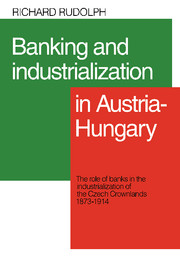 Banking and Industrialization in Austria-Hungary
Banking and Industrialization in Austria-Hungary Book contents
- Frontmatter
- Contents
- List of tables and charts
- Preface
- Abbreviations
- Introduction
- 1 Industrial development in the Austro-Hungarian Monarchy 1873–1914
- 2 Industrialization in the Czech Lands
- 3 Evolution of the financial structure
- 4 The relationship of banks to industry: the Viennese Great Banks
- 5 The relationship of banks to industry: the Czech banks
- 6 Sources of industrial credit
- 7 The role of the banks
- Appendixes
- Notes
- Select bibliography
- Index
Preface
Published online by Cambridge University Press: 05 January 2012
- Frontmatter
- Contents
- List of tables and charts
- Preface
- Abbreviations
- Introduction
- 1 Industrial development in the Austro-Hungarian Monarchy 1873–1914
- 2 Industrialization in the Czech Lands
- 3 Evolution of the financial structure
- 4 The relationship of banks to industry: the Viennese Great Banks
- 5 The relationship of banks to industry: the Czech banks
- 6 Sources of industrial credit
- 7 The role of the banks
- Appendixes
- Notes
- Select bibliography
- Index
Summary
The economic history of the Austro-Hungarian Monarchy is still largely uncharted and research concerning the area is just beginning. The discussion in this work of the relationship between the banks in the dual monarchy with the primary industrial region, the Czech Lands, is offered as one contribution to the large body of research which must still be undertaken with regard to the process of economic development in Austria-Hungary. In studying the economic history of this area, one quickly feels the absence of the fact gatherers, analysts, and econometricians encountered in the fields of American or British economic history. It is the absence of predecessors of this kind which give the present work something of its exploratory character. While the general tenor of the study is analytical and an attempt has been made to utilize economic theory, it was felt that the specification and testing of particular hypotheses might well miss the mark widely until more of the general features of economic development in the area were established.
It will be noted that two units of currency are utilized in the body of the work. With the adoption of the gold standard and the reform of the currency in 1892, the crown (krone) replaced the gulden. In charts and instances of comparison values are expressed in crowns (2 crowns = 1 gulden), but in discussing the period before the turn of the century Austrian usage has been followed and values are expressed in gulden.
- Type
- Chapter
- Information
- Banking and Industrialization in Austria-HungaryThe Role of Banks in the Industrialization of the Czech Crownlands, 1873–1914, pp. x - xiPublisher: Cambridge University PressPrint publication year: 1976
